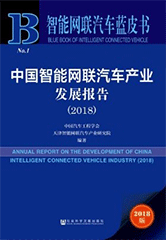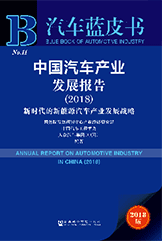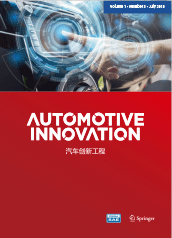

|
The journal Automotive Innovation is sponsored by China SAE, jointly published by China SAE and Springer, and reflects the top-level research and technical advance of automotive engineering. Automotive Innovation newsletter in October includes the following contents: 1. A Glimpse of Experts-Prof. Sun Fengchun, an academician of CAE, expert on EV 2. Article Recommendation-Four papers published in Automotive Innovation 3. China SAE News-《Blue Book on Intelligent and Connected Vehicles》 and 《Blue Book on China Automotive Industry》 published |

 Prof. Sun Fengchun ● Academician of China Academy of Engineering (CAE) ● Professor of Beijing Institute of Technology ● Director of National Engineering Laboratory for EV ● Director of National Monitoring and Management Center for New Energy Vehicles |
Research interests Design, integration and control of electrified vehicles, battery charging/exchanging station infrastructure development and operation management, big data for connected electrified vehicles. |
||
|
Achievements Prof. Fengchun Sun led his team and established China's "Electric Vehicle Charging/Exchanging and Remote Monitoring” technology system for commercial electric vehicles. He developed the key technology of power transmission system and the first ultra-low floor electric bus, which enabled China's electric buses to lead the international advanced level in terms of technology and energy consumption. At the same time, his great contribution to the industrialization process has created great social, economic and environmental benefits. He presided over the development of hybrid powers-wire-controlled multi-wheel distributed electric drive key technology, promoting the cross-generation upgrading of China's military vehicle power transmission technology. He invented a series of technologies such as advanced battery management system, battery charging/exchanging stations and remote real-time monitoring technology. He took the lead in establishing the earliest electric vehicle operation standards in China, as well as implementing zero-emission national key transportation demonstration projects such as Beijing Olympic Games, Shanghai world expo, Guangzhou Asian games and APEC. These achievements vigorously accelerated the development of strategic emerging industries. Prof. Sun has won two Second Class Prizes of China National Technology Invention Award, one Second Class Prize of China National Scientific and Technological Progress Award, and Ho Leung Ho Lee Technology Innovation Award. He obtained 65 invention patents, published more than 210 research papers that have been cited for more than 6,000 times. He has won the honorary title of “National Model Worker”. |
|||
|
Perspective: challenges and development trends for electric vehicles The development of electric vehicles in China still faces major technical challenges in several aspects such as all-solid batteries, high-performance energy storage materials, information processing chips with high computational capabilities, efficient and reliable power chips, operating systems for new energy vehicles, fuel cell and electric-wheels with high power density. In the future, materials science, computer science, control science, mechanical science, chip manufacturing technology and key component technology should be combined, focusing on all these resources, advantages, and background knowledge to solve the challenges. |

   
|
Metamodel-Based Multi-Objective Reliable Optimization for Front Structure of Electric Vehicle Fengling Gao, Shan Ren, Cheng Lin, Yingchun Bai, Wenwei Wang |
||
| In this paper, a multi-objective reliable optimization (MORO) procedure for the front body of an electric vehicle is proposed and compared with determinate multi-objective optimization (DMOO). The energy absorption and peak crash force of the simplified vehicle model under the full-lap frontal impact condition are used as the design objectives, with the weighted sum of the basic frequency, the first-order torsional and bending frequencies of the full-size vehicle model, and the weight of the front body taken as the constraints. The thicknesses of nine components on the front body are defined as design variables, and their geometric tolerances determine the uncertainty factor. The most accurate metamodel using the polynomial response surface, kriging, and a radial basis function is selected to model four design criteria during optimization, allowing the efficiency improvement to be computed. Monte Carlo simulations are adopted to handle the probability constraints, and multi-objective particle swarm optimization is employed as the solver. The MORO results indicate reliability levels of \(R = 100\)%, demonstrating the significant enhancement in reliability of the front body over that given by DMOO, and reliable design schemes and proposals are provided for further study. | |||
|
Keywords: Multi-objective reliable optimization, Electric vehicle body, Metamodel technique, Monte Carlo Gao, F., Ren, S., Lin, C. et al. Automotive. Innovation. (2018) 1: 131. https://doi.org/10.1007/s42154-018-0018-8 |
|||
| Full Paper Reading>> | |||
   
|
Performance of the Transmission Parking Mechanism of a Battery Electric Vehicle Simulated with Adams Software Yuan Dong, Yong Chen, Chuang Yu, Zhan Cao, Guangxin Li, Zhuoqiang Li, Genqun Cui |
||
| The electric parking mechanism is studied for an electrically controlled two-speed auto transmission that is being developed for electric vehicles. Safety requirements include low-speed safe parking, reliable self-lock and the avoidance of abnormal parking. A dynamic model of the parking mechanism is established and analyzed using Adams software. Finally, failure of the parking mechanism due to wear is observed in bench testing and compared with experimental results after optimization. | |||
|
Keywords: Battery electric vehicle, Two-speed auto transmission, Parking mechanism, Safety performance Dong, Y., Chen, Y., Yu, C. et al. Automotive. Innovation. (2018) 1: 114. https://doi.org/10.1007/s42154-018-0023-y |
|||
| Full Paper Reading>> | |||
   
|
Modeling and Testing of the Multi-pole field of a Motor for Pure Electric Vehicles Dongchen Qin, Lei Cheng, Tingting Wang, Yingjia Wang, Yaokai Wang |
||
| From the principles of electromechanical energy conversion and electromagnetic torque generation, our study evaluated the mathematical model of the electromagnetic torque and the vector control method of motors. An analysis of motor types indicate that the electromechanical energy conversion component is interchangeable. Three distinct types of motor structures, namely, DC, induction, and synchronous, are possible, all three being commonly used in pure electric vehicles. For each motor type, simulation models were developed using Modelica, a modeling language for object-oriented multi-domain physical system. A test model of each motor type was configured in the MWorks simulation platform. With a representative motor, specifically, the permanent magnet DC motor, the asynchronous induction motor, and the permanent magnet synchronous motor, mechanical properties were simulated and analyzed. The simulation results show that the characteristics of each motor model are consistent with the theoretical and engineering performance of the representative motor. Therefore, modeling, motor control, and performance testing of a unified multi-pole-field motor, which is used in pure electric vehicles, has been achieved. | |||
|
Keywords: Electric-motor vehicle, Multi–pole field, Unified modelling, Electromechanical energy conversion Qin, D., Cheng, L., Wang, T. et al. Automotive. Innovation. (2018) 1: 226. https://doi.org/10.1007/s42154-018-0025-9 |
|||
| Full Paper Reading>> | |||
   
|
Torque Distribution Strategy of Electric Vehicle with In-wheel Motors Based on the Identification of Driving Intention Bo Peng · Huanhuan Zhang · Feihu Xuan · Wenwen Xiao |
||
| A driver’s intention is recognized accurately by employing fuzzy identification and a logic threshold including acceleration intention and steering intention. Different torque distribution control strategies are developed for different intentions and the driver’s torque demand is amended by fuzzy identification so that the response of the vehicle is more consistent with the driver’s intention of operation. Finally, a simulation model is built using MATLAB/Simulink to validate the control strategy. Simulation results show that the system accurately identifies the driver’s intention and improves the acceleration performance and steering stability of the vehicle. | |||
|
Keywords: Fuzzy recognition · Torque distribution · Driving intention · In-wheel motors · Steering stability Peng, B., Zhang, H., Xuan, F. et al. Automotive. Innovation. (2018) 1: 140. https://doi.org/10.1007/s42154-018-0024-x |
|||
| Full Paper Reading>> | |||

 |
|||
| Blue Book of Intelligent and Connected Vehicle——《Annual Report on the Development of China Intelligent Connected Vehicles Automotive Industry(2018)》Published | |||
| This book is an annual research report on the development of China intelligent connected vehicle automotive industry jointly compiled by the senior experts organized by China SAE and Tianjin ICV Industry Research Institute. This year’s report includes general report, industry chapter, technical chapter, application chapter, hot chapter, policy chapter and reference chapter. Among them, the general report builds an evaluation system for the international competitiveness of the intelligent connected automotive industry, and the industry chapter analyzes the industrial chain and market statistics, and the technical chapter centers on the development and trend of the common key technologies, and the patent situation; and the reference chapter introduces the advanced experience abroad, including the HD map data platform in Japan, automated driving tests in California and so on. | |||
 |
|||
| Blue Book of Automotive Industry—《Annual Report on Automotive Industry in China(2018)》Published | |||
|
This book is compiled by Development Research Center of State Council, China SAE and Volkswagen Group. Taking “New Energy Vehicle Industry Development Strategy in the New Ear” as the theme, the annual report comprehensively analyzes and systematically elaborated the current situation and trends of new energy vehicle industry at home and abroad, new ideas and measures for the development of China’s new energy vehicle industry in the Post-Subsidy Era, and new opportunities for the development of FCV in the context of hydrogen economy. It also dynamically analyzes the trend of the break-even point of the whole life-cycle cost of new energy vehicles from 2020-2030 based on the theory of industrial life-cycle and the theory of learning curve and new ideas and policy suggestions in the post -subsidy era have been put forward pointedly. The research finds that China's new energy vehicles are currently at the key node transitioning from the introduction stage to the growth stage. With the decline of the subsidy, the pure electric passenger vehicle will not be able to compete with the traditional vehicle until 2020 and the relevant policy supports are still needed. |

|
Automotive Innovation The first top English academic journal of China's Automotive Industry ● Global subscription ● Reflecting the top-level research and technical advance of automotive engineering ● A good platform for demonstrating the technology innovation on automobiles Editors-in-Chief Li Jun, Academician of CAE, President of China SAE, Professor of Tsinghua University Frank Zhao, President (2018-2020) of FISITA, President of Tsinghua Automotive Strategy Research Institute |
||||
|
Executive Editor-in-Chief Prof. Mike Ma,Executive Chief Editor of Automotive Innovation, Professor of Jilin University, VP Technical FISITA Paper submission and browse www.ChinaSAEJournal.com.cn www.springer.com/42154 Contacts: Ms. Huisi, Gu Tel: +86-10-50950101 Email: ghs@sae-china.org |

|
|||
|
Sponsored |
Co-operated with
|
|||